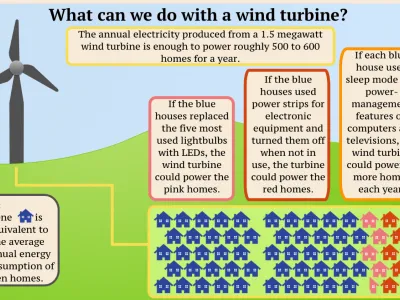What's a Watt?

One of our roles at CUB is to help Minnesotans better understand their energy options. To do that, we also want to help people understand some of the basic, technical aspects of energy, such as measuring it. In most of our homes, energy as a resource is something we can’t see, feel, hear, or touch. We just flip a switch, and a light turns on. On top of that, the unit of measurement for energy, a kilowatt-hour (kWh) can be hard to understand. Instead of thinking about energy use and production in kilowatt-hours, it can be helpful to think about kilowatt-hours in terms of day-to-day life. This blog post will look at what certain amounts of energy mean in terms of use by the average consumer. Let’s start with the production of energy from a single wind turbine. Many wind turbines in Minnesota have the capacity of 1.5 megawatts (MW). That means that turbine will produce 1.5 megawatt-hours of electricity (or 1500 kWh) when it runs at full speed for one hour. A wind turbine with that capacity will produce roughly 5,000,000 kilowatt-hours (kWh) in a year. The average Minnesota home uses 764 kWh each month, so this amount of energy can power about 550 homes for a year. If we look at one appliance, that same amount of energy would be enough to power an average size fridge for up 10,000 years. This sure is a lot of energy for one single wind turbine, but how do smaller amounts of energy translate to day to day life? To break it down, let’s look at how long certain amounts of energy could power the average home. It takes one thousand watt-hours to add up to a single kilowatt-hour, and one thousand kilowatt-hours to add up to one megawatt-hour. When compared to the large production of a wind turbine, one watt-hour can seem minuscule. However, in day-to-day life, this amount of energy can still help run the house. For example, what can we do with eight watt-hours? With 8 watt-hours, we can power one 8-watt LED light for one hour. Eight watt-hours is just .08 of a kilowatt-hour, but this amount of energy can go a long way when coupled with energy efficient practices in the home. The info graphic below, based on a report from the U.S. Department of Energy, shows us the importance of coupling big generation with small household energy-saving practices. As illustrated, seemingly small choices, like which light bulb to use, add up. Switching the five most used light fixtures in the home to LED light bulbs saves the average family nine percent on their electricity bill per year. With nine percent more energy from all 500 homes, a wind turbine can power up to forty-five more homes in a neighborhood. When we couple energy-saving practices with clean energy, we can stretch the use of that clean energy a long way.